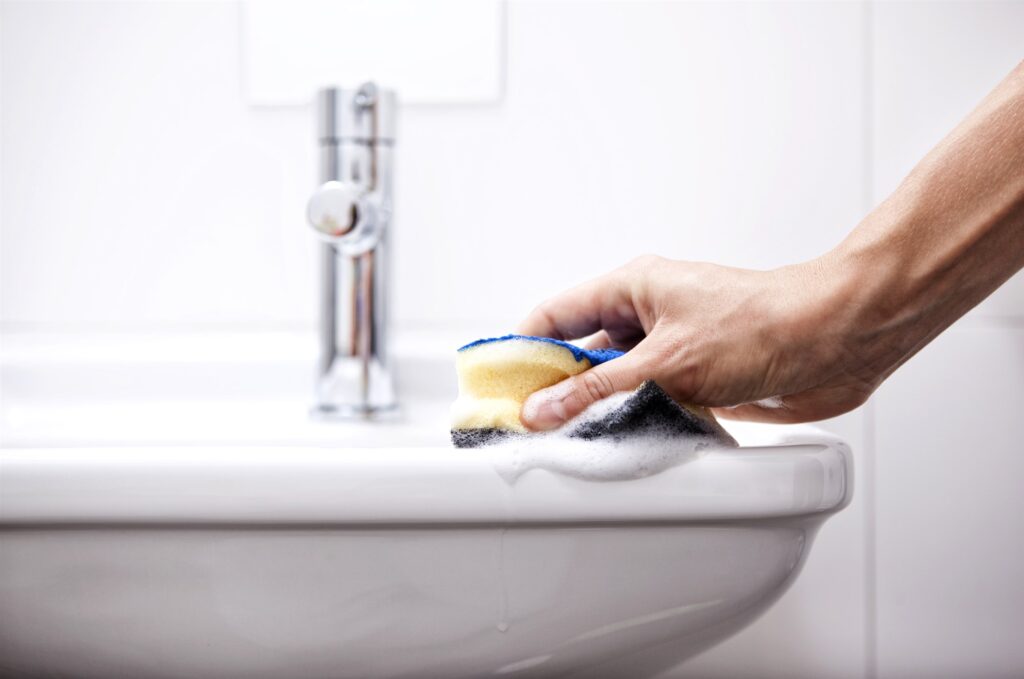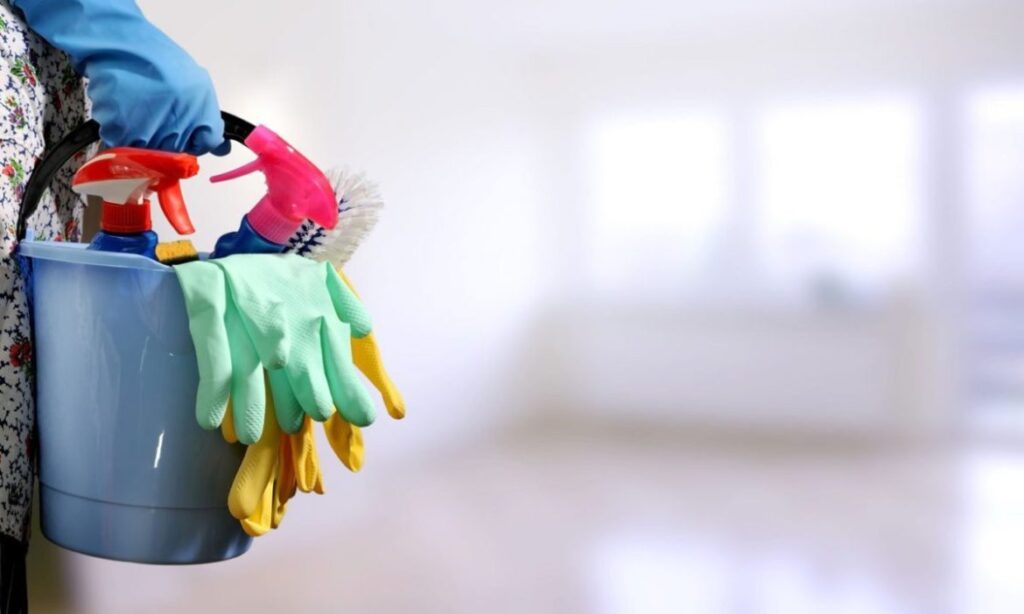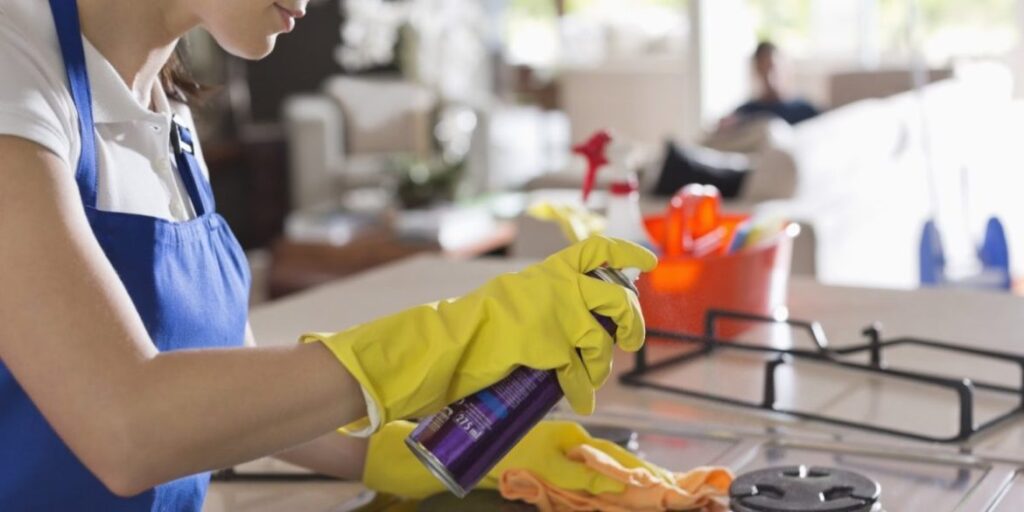A housecleaning routine you can actually stick to
The problem is that I have essentially set myself up for failure by saving all my cleaning for one day and without any kind of a plan. The trick is to create a cleaning routine that I can actually stick to. What might such a routine look like? Here’s what the experts helped me come up with.
Assess the mess and prioritize with a physical checklist
Nailing down the specifics should be your first step. What needs to be cleaned and how much time will it take? “Look around and ask yourself which areas of your home bother you the most when they’re dirty? These will be the highest priority,”
suggestion of looking around the house and assessing what needed to be done, but I still found myself overwhelmed, because basically everything is overdue for cleaning. This is where getting super organized can help. Start by writing tasks down, room by room in a checklist format. “Writing out each room’s chores will assist in staying organized and create a visual kudos as you begin to check off each task,” says
It’s a good idea to type up this list and print it out so that you (and everyone else in your house) can refer to it later. “I have a bathroom cleaning checklist inside of a cupboard in each of our bathrooms,” says
It’s crucial to be realistic with your goals. “A consistently sparkling home would be great, but it’s not always sustainable and one of the most common reasons people give up after a short time,” says

How To Get The Most Out Of Your House Cleaning Company
Everyone wants a clean, comfortable living space, but there are better ways to spend your spare time than dusting and mopping. It’s no wonder so many people hire a house cleaning company to handle their dirty work! Between managing work, family time, and maintaining a social life, housework is bound to fall off the radar on occasion. We’ve all been there. That said, time is money. So, if you choose to hire a house cleaning company, you’ll want to make sure you get the most value possible from every moment they spend in your home.
Remove Clutter and Tidy Up
Have you ever been guilty of leaving dishes in the sink? Tossing dirty laundry on the floor or a chair? Forgetting to put your shoes in the closet when you come home? Of course! You’re human and, by virtue of going about your life, you create clutter in your house.
Clearly Communicate Your Priorities
While you don’t want to micromanage every aspect of the cleaner’s job, it’s a good idea to outline what you expect from their services. Prioritize what you want to be cleaned by room, objects and surfaces within a room, and the type of cleaning you’d like done. For example, if you want the entire main floor cleaned, should the cleaner focus on vacuuming the carpets, mopping the floors, dusting the floorboards, or cleaning certain objects and surfaces?
We recommend prioritizing your least favorite cleaning chores and those that take up the most time. These might include:
Cleaning the windows, including both sides of the pane, the sills, blinds, shutters, and curtains
Dusting hard-to-reach ceiling fans and light fixtures
Flipping and steaming your mattress
Vacuuming under the beds
Scrubbing toilet bowls, showers, and bathtubs
Unclogging sink and shower drains
Stock Up on Cleaning Supplies
Most professional house cleaning companies come fully equipped with their own supplies, but it doesn’t hurt to have a few extra rags, towels, and mop heads on hand. It’s also a good idea to keep extra cleaning spray, garbage bags, and cleaning gloves in the house just in case. If you want the cleaners to use a specific product for certain surfaces, be sure to tell them ahead of time.

The Deep Cleaning House Checklist to Follow & Room-by-room Chores
A clean and happy home is what we all strive for. But deep cleaning a house can be an overwhelming task (and it sure is). That’s why we often postpone the checklist of chores for the indefinite future. But it doesn’t have to be that way.
without further ado, the deep cleaning house checklist starts with:
A few Main Tips:
Use this checklist and guide to turn deep cleaning into a pleasant exercise. Use our template for your personal cleaning checklist.
Spend more time on items and areas around the house that you rarely clean, such as the oven. Bear in mind, that professional oven valeting comes with the dismantling and separate cleaning of racks, which is always the better choice.
If you live in a house with over one storey, gather all cleaning products and tools so you save time up and down the stairs only to get something you forgot.
An extensive clean needs the right set of tools:
Cleaning cloths or old towels;
1 bucket for dirty water and 1 bucket for clean water;
Degreaser and dish soap of your choice;
1 spray bottle to prepare a solution of 1 part vinegar and 1 part water;
1 set of rubber gloves;
An old toothbrush – it’s a great way to give a second life to your old toothbrush since it’s perfect for scrubbing dirt, mould and tile grout.
A regular household detergent. Just mind the dangers.
Main House Areas Deep Cleaning
First, you should deep clean the main areas in the house or apartment. Here’s what the domestic cleaners’ team had to share:
Use a stepladder with caution to wipe down surfaces hard to reach and usually skipped during the weekly cleaning routine: top of wardrobes, bookshelves, and cabinets; window frames, light fixtures, paintings, and framed photos.
Ask a family member to help you move and clean big and heavy furniture and appliances (sofas, wardrobes, washing machine, dishwasher, fridge, etc.) so you can wipe the floors and walls below and behind them.
Remove limescale from faucets and showerheads in the entire house using vinegar.
Dust and polish all pieces of furniture with the right products depending on the material they’re made of.
Take care of the cooling and heating systems around your home: dust the blades of the ceiling fans, remove the AC filters and wash them with lukewarm water and dish soap.
Clean doors and door frames from smudges, get rid of bugs and cobwebs that have accumulated in the corners of windows and doors.
Spray the blinds in your home with the 1:1 vinegar and water solution, then scrub them thoroughly.
Remove any stains from carpets and upholstery. Check our guide on cleaning wool carpets.
Vacuum or mop all floors: carpets, hardwood, tiles, linoleum. Consider booking a professional service for hot water extraction or dry chem cleaning of your carpets/rugs.
Polish hard floors if present. This is best done by a hard floor cleaning service.
Pull out the cushions of chairs and sofas and vacuum underneath them.
Clean the sofa cushions. Wash via dishwasher or by hand.
Throw out the trash and then pay special attention to the recycling bins and garbage cans. You have to wash and sanitize those at least several times per year.
Take all items out of drawers and cabinets, wipe them both inside and outside.
Check the expiration date of food products in cupboards and fridge, of cosmetics in bathroom cabinets, of medication and vitamins. Throw away anything that has already expired and place the items close to their expiration date in front of others.
If you have children, clean and organize their clothes and toys.
If you have pets, make sure to wash their food and water bowls, as well as clean their bed or aquarium.
Wipe all remote controls, smartphones, and other small appliances.

Office safety checklist – Creating healthy spaces with an office cleaning plan
Why are we talking about this? Cleaning may not be our focus, but it is an important part of the story for returning to the workplace after the COVID 19 pandemic. We’ve collected some of the most useful research to help you navigate the right way to manage some of the common safety concerns as you go from remote work to reopening the workplace.
Once everyone returns to work, we’ll find ourselves thinking differently about the equipment and surfaces around us, reaching for disinfectant wipes where we’d never give a second thought before. While it’s understandable to experience a little apprehension as we venture back to the office, it’s achievable and valuable to keep our common spaces healthy. Whether engaging in maintenance cleaning, or CDC-advised disinfection for exposed spaces, office cleaning practices come down to the same basic tenets: The right equipment, a solid plan, and a team
Use the right office cleaning process
While our reaction to the virus has been (understandably) to default to “disinfect everything,” in everyday situations the CDC guidance recommends cleaning rather than disinfection. What’s the difference? In short:
• Cleaning is for routine health and wellness. Washing down surfaces using a green cleaner or a simple soap-and-water solution can make them safe by removing dust and dirt. This also physically removes germs by picking them up (either in a paper towel or cloth) to safely remove them.
• Disinfection, on the other hand, kills germs by means of a chemical process. The CDC recommends disinfection only when when a risk is present someone has been working in or visiting the office while carrying a contagious illness; it doesn’t have to occur for routine cleaning.
Gather the right cleaning tools
Depending on the reason for cleaning (simple cleaning, deep cleaning, or disinfection) you’ll have a few items on your checklist:
☐ Nitrile gloves (latex can cause allergic reactions in some individuals)
☐ Paper towels, or microfiber cloths (if you can wash and sanitize them after use)
☐ Green cleaning spray
☐ Disinfecting wipes, spray, or a correctly-diluted bleach solution
☐ Trash bags
☐ For disinfection: A properly-rated respirator mask and protective gown
Create an office safety and health plan
To create a cleaning routine, it helps to think about the typical hotspots that transmit bacteria and viruses.
1. Make a note of the traffic through certain areas of the workplace, and the ways in which space is used-or not. In the course of this mental inventory, you may even uncover ways to improve or maximize your space usage as a side-benefit to your cleaning plan development. For instance, you may find areas you don’t need to attend to for cleaning purposes. They may turn out to be underutilized real estate.
2. Look through your office one area at a time, and note the high-touch areas in each. Some of the typical transmission vectors in spaces include:
• Tables and desks
• Countertops
• Chair-backs
• Doorknobs
• Light switches
• Cabinet pulls and handles
Some of the other high touch areas in your office spaces to consider:
Front desk and reception areas
• Phones, computer mice, and keyboards
• Desk accessories such as staplers, tape dispensers, and pen-cups
• Digital touch screens
• Elevator buttons
• Coat-racks and hangers
Kitchen and break rooms
• Appliance handles and controls (fridge, toaster, oven, dishwasher)
• Fixtures
• Chair-backs at seating areas
• Coffee station and coffee/tea service items
Bathrooms
• Bathroom fixtures (toilet handles, faucets, soap and towel dispensers)
• Waste-bins
• Door and stall handles
• Changing stations and convenience item dispensers
Conference and meeting rooms
• Technology controls such as speakerphone buttons, remotes
• Televisions, touch screens, and projectors
• Whiteboard accessories such as pens and erasers
Mail and resource rooms
• Postage meters, scales, and dedicated shipping computers
• Packaging and mail tools such as tape guns, letter openers, box cutters
• Rolling package bins, trolleys, and carts

Things You Should Deep Clean in the New Year
After the holiday parties are over and the decorations are put away, a deep cleaning is just what your home needs. And since you’re stuck inside anyway, there’s no better time to take on the overlooked areas of your home (like the grout in your shower!). We’re here to help you start the new year off right with a clean home, so we’ve put together this list of things you should deep clean this month.
Fridge: After tossing old holiday leftovers, wipe the shelves and door with a microfiber and an all-purpose cleaner made with plant-based ingredients. Pull your fridge out from the wall and unplug it. Then use your vacuum’s brush tool to gently clean the coils. (If your fridge has a removeable grille in the front, unsnap or unscrew it to get to the coils from the front of the fridge.)
Oven: Corrosive chemicals in oven cleaners may cause breathing difficulty or skin irritation. Fortunately, you can make a surprisingly effective oven cleaner with a paste of ½ cup of baking soda, 1 tablespoon of dish soap, and water (about the consistency of toothpaste). Rub the paste into the turkey drippings and other grime on the walls and bottom of your oven. Leave it for 5 minutes, then wipe clean with a wet rag or microfiber. To reach the back of the oven, wrap the microfiber around a spatula or long-handled spoon.
Cabinets: Dish soap isn’t just for pots and pans — it’s also an efficient (and inexpensive) degreaser for the rest of your kitchen. Clean spattered oil and gummy fingerprints on cabinets with soapy water and a microfiber cloth. Don’t forget to wipe the hardware, corners, and inside edges of the doors.
Bathrooms: In addition to your regular cleaning, your shower and tub might need extra attention after holiday guests. However, deep cleaning shouldn’t involve breathing in harsh fumes. Saturate your tile and grout with Seventh Generation tub & tile cleaner, which is made of plant-derived cleaning agents. Let it sit for 5 minutes, then scrub buildup with a stiff brush.
Windows: Window cleaners may contain ingredients like ammonia and isopropyl alcohol that may irritate your lungs. To remove gunk without these ingredients, rub a dollop of mayonnaise into sticky spots from window decals and scrape with a plastic spatula (never use a razor blade, which can scratch the glass!). Spray Seventh Generation Glass and Surface Cleaner on the frame, ledge, and hardware and wipe clean. Then spray the cleaner on a microfiber cloth and wipe the window top to bottom in a “Z” pattern. If the weather allows, wipe the outside of windows and glass doors, too.
Vent covers: In addition to choosing cleaners with low levels of Volatile Organic Compounds (VOCs), cleaning your vent covers is an easy way to help protect your home’s indoor air quality. Get rid of dust bunnies and allergens by unscrewing vent covers and placing them in a sink filled with hot water and a squirt of dish soap. Wipe the covers carefully with a microfiber, dry, and replace.
Carpet: Carpet can trap (and hold) dust, dirt, pet dander, and allergens. To freshen and deodorize your carpet, you don’t need special cleaners — just sprinkle baking soda on the entire area and let it sit for at least an hour (the longer, the better). Vacuum it up and repeat if needed.
Mattress: Baking soda actually neutralizes odor-causing acids to eliminate the funk — so it’s great for freshening up your mattress. Toss sheets in the wash and sprinkle the mattress with baking soda. (You can also combine 1 cup of baking soda and 2-3 drops of your favorite essential oil in a jar for an aromatherapy boost.) Let the baking soda sit for an hour, then vacuum it up with your vacuum’s upholstery tool.
Bedding: While your mattress is airing out, machine wash blankets and pillows on the delicate cycle with cold water and biobased detergent. Add an extra rinse cycle to get out any lingering detergent, and wash two pillows at a time to keep the machine balanced. For bulky comforters, a large machine at the laundromat might be your best bet. When it’s time to dry, choose the low setting and add a few tennis balls to fluff everything back up.
Washing machine: To get rid of mineral deposits and detergent buildup without the “bleachy” smell, add 2 cups of vinegar to the drum and 1 cup of baking soda wherever you normally add your laundry detergent. Run the machine on the longest cold water cycle. Use a rag and all-purpose cleaner to wipe the rubber gasket around the door (if you have a front-loader) or under the lid and rim of the tub (if you have a top-loader).